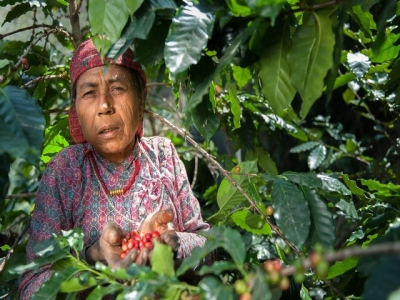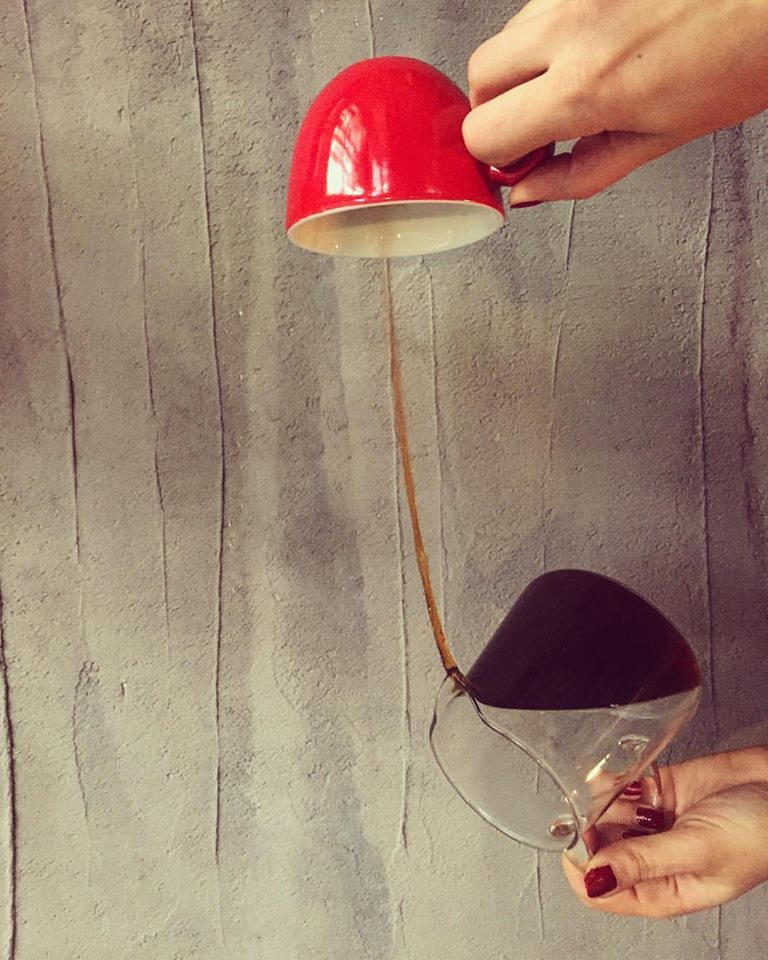by Jennifer Lan
Bhavana Coffee, Founder
Nepal inspires a physical beauty and graceful wonder from mountaineers summiting Everest to trekking though the Himalayas, or seeking serenity in monasteries. What you might not have experienced yet is coffee from Nepal. That’s right, coffee.
Did you know Nepal grows amazing specialty coffee beans? While growing coffee is a fairly new endeavor here, the foothills of the Himalayas foster an extraordinary mix of altitude, soil, moisture, and climate. You won’t find it on any Specialty Coffee Maps, but scoring well above 80 on the specialty coffee scale, Nepal is emerging as an exciting new origin for coffee.

GROWING COFFEE 101
Great coffee starts from the coffee cherry and everything you know about what’s needed to grow coffee goes back to growing the most flavorful cherry. Nepal lies outside of the typical “coffee belt” which sits between the Tropic of Cancer and the Tropic of Capricorn, where Arabica coffee thrives. This is why it’s so rare to find all the important factors such as climate, altitude, water and soil composition existing in the hills of Nepal. Whether it’s a result of climate change or other factors is beyond the scope of this article, but it’s a great example of why we never stop challenging what we think we know.
Coffee production in Nepal is still comparatively small scale. Annual production hovers around 500 metric tons, with some of the larger estates growing 1-5 tons annually, and far more farmers with just a handful of plants growing in cooperatives. The farmers use organic fertilizers of compost and manure and pesticides that they can create on the farm. Coffee trees are typically interspersed with fruit and nut trees. Not only does this diversify the farmers crop, it aids in soil conservation and biodiversity, and coffee actually grows better in the shade. Shade-grown coffee slows down the ripening process and produces a more flavorful cherry. The producers we work with continue to push the bar in farming, looking for the best techniques in pruning and planting. There is only one harvest per year usually running from February to April. During this time, the cherries are harvested by hand with emphasis taken to only collect the ripe cherries rather than sweep an entire branch. It’s one of the busiest time of the year! 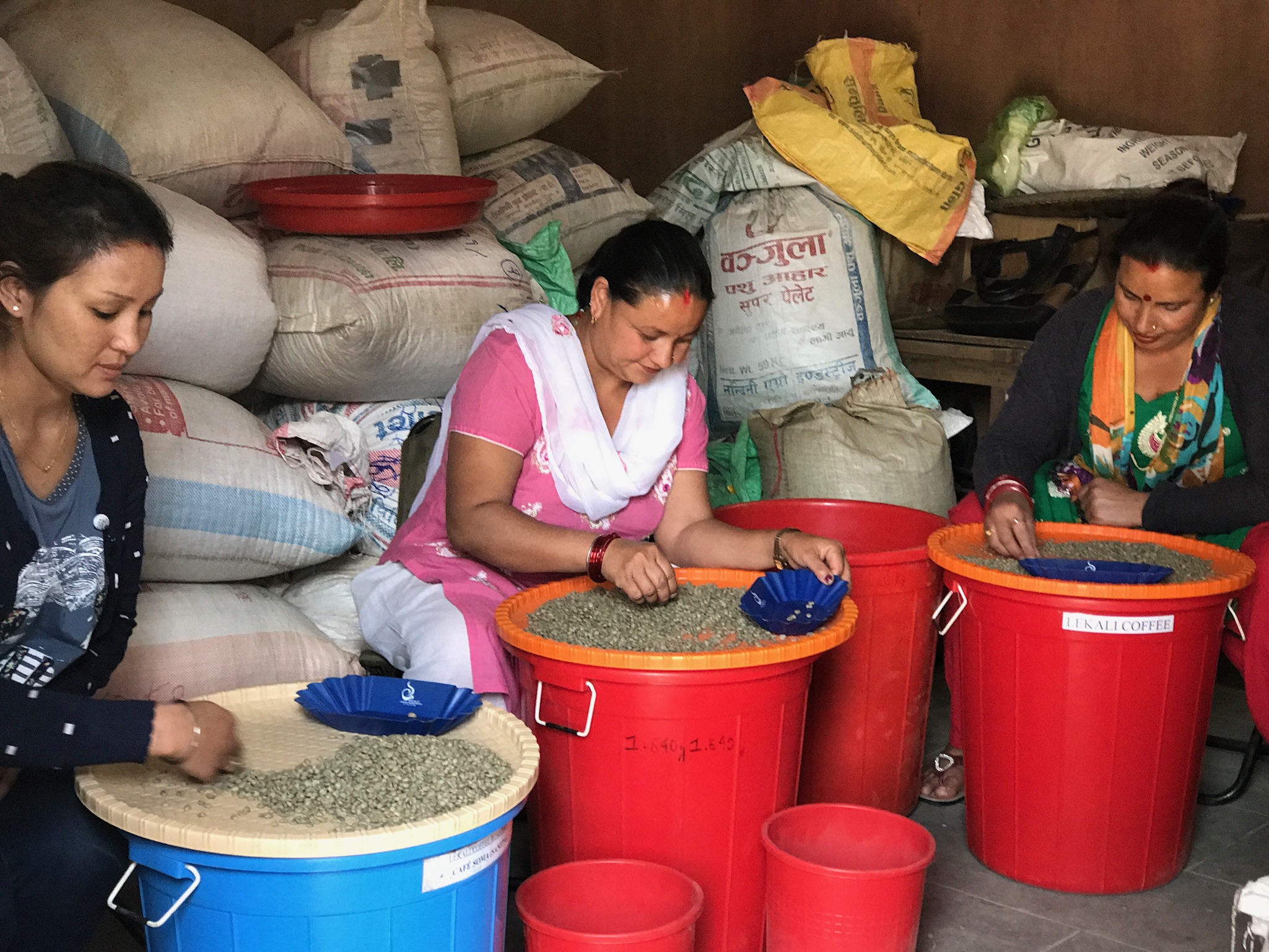

Each day after picking, comes the processing. Most of it will be wet processed/ fully washed meaning that it will be pulped, fermented, and washed before the seeds (better known as coffee beans) are dried down. First, the cherries will be put in water to check for “floaters” or bad fruit. Then they are pulped to separate the fruit from the seed, and put in plastic or metal containers to ferment which will break down any remaining mucilage. Following that, they are washed (and finally laid out to dry). Most of the farms we work with will dry on raised and covered beds until about 10-12% moisture content. Some of the farmers we work with continue to push innovation in processing techniques experimenting with a double washed method and yeast fermentation. 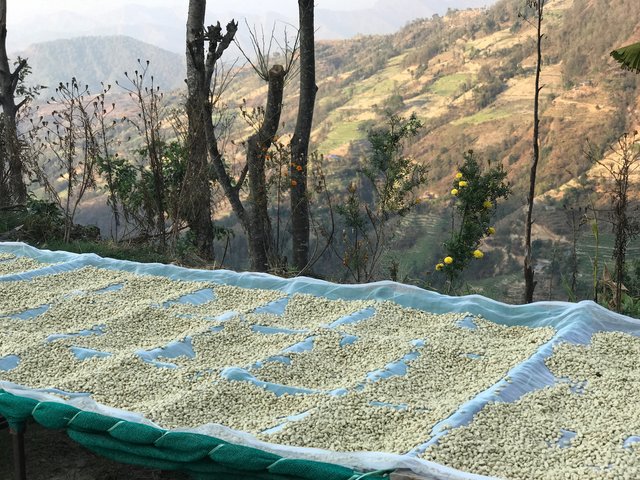

Another factor contributing to taste is the coffee varietal grown. Varietals, similar to wine, will ultimately contribute to the flavors in your coffee. While all the coffee grown in Nepal is Arabica, I’ve found great varietals such as Bourbon, Yellow Caturra, and Typica already growing well, and promising varietals such as Geisha and Pacamaras coming in the near future.
MEET THE PEOPLE
This is seriously good coffee, and it’s also coffee with good karma. Being able to make a living growing coffee has changed prospects and livelihoods for those involved with coffee farming. I spoke with one of the farm managers, Arjun, who lived with his beautiful family of 4 daughters. Typically, in Nepalese culture, daughters will get married and move to live with their husband’s family and the older generations are taken care of by the younger ones living with them. You can see the insecurities faced by not having a son. Arjun and his family have been blessed to become a central force of employment for his village and he no longer worries about not having a support system.
Here are a few things you should know about Nepal’s economy. It’s largely an agrarian economy with farming activities employing more than 70% of its population and accounting for a little over 1/3 of its GDP. Nepal is also heavily dependent on remittances (money being sent back from people who leave to find work elsewhere due to the lack of opportunities at home), accounting for ¼ of its GDP. A quarter of the population lives below the poverty line and unemployment is as high as 50%.
Painted this way, it’s a bleak picture but what I want to point out is the difficulty of an economy having little industry. In the last few years there has been international aid as a result of the natural disasters that struck Nepal such as a major earthquake in 2015 and devastating monsoon floods in 2017. That’s been helpful, but there is a difference between aid which addresses emergency relief and rebuilding efforts versus sustainable development.
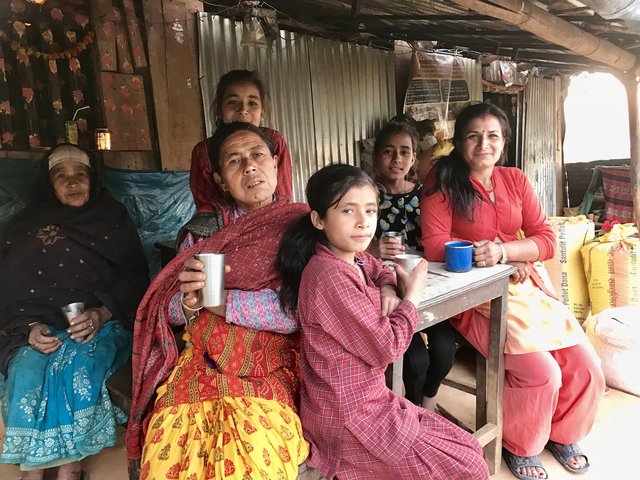
Getting to know the small business owners, the start up founders, and the business and community leaders, was one of the most inspiring and fulfilling things I experienced. People can make a difference and one step at a time progress was being made all around me because of indomitable spirit. There were 2 school buddies with no background in coffee or farming who decided to go on an adventure together, making mistakes and learning along the way, bootstrapping their way to success over the last 8 years. There were coffee producers who were laser focused and tirelessly pushing the quality of specialty coffee produced in Nepal forward. One woman in particular resonated with me. Not only was she one of the few female entrepreneurs who had succeeded in building a successful coffee estate, but she had an incredible sense of humanity to go with it. Using the success of the coffee estate as a spring board, she created a nonprofit geared to help the community battle human trafficking issues it was facing. That same altitude that enables great coffee makes it hard to access education. They have built 4 schools in the area and continue to fund its operations and provide teachers for those schools.
HOW BHAVANA COFFEE WAS BORN
I came to Nepal as a visitor and tourist, but after seeing the convergence of so many positive things, I was inspired to start Bhavana Coffee. What the industry needs right now is access – access to markets, to knowledge, and to capital. Specialty grade coffee requires investments at the farm level but for many producers this requires going into debt. Even for those able to take the risk, the access to debt and credit is another difficult hurdle. We are investing early in this market, paying the farmers more than double what other importers are and working hard to get them the knowledge and exposure they deserve. We match the farms that are producing amazing specialty coffee beans with a craft roaster in Denver who takes the next step in creating an exceptional cup of coffee.
Our coffee goes through a rigorous test roasting process to make sure we bring out the flavors to their full potential. We also take care that it’s roasted in small batches and basically to order. We really want to showcase this amazing and responsibly produced coffee!
It’s not hard to see why Nepal is such a unique and captivating origin for coffee. Its unique ecosystem, combined with dedication and passion from the Nepalese farming communities and expert local roasting, results in a rare and special coffee. I hope that this has inspired you to want to stay engaged with Nepal and try our coffee.
Head over to www.BhavanaCoffee.com for more updates and how to order!


